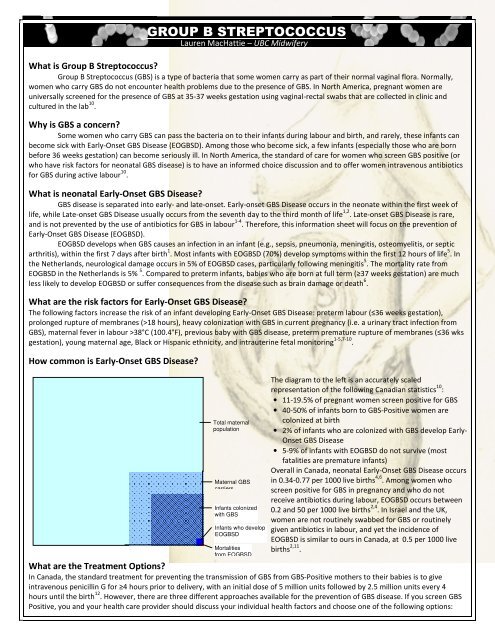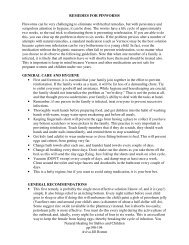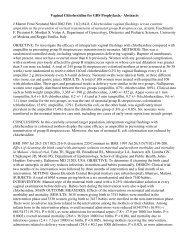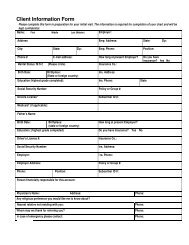GROUP B STREPTOCOCCUS - GAmidwife.com
GROUP B STREPTOCOCCUS - GAmidwife.com
GROUP B STREPTOCOCCUS - GAmidwife.com
Create successful ePaper yourself
Turn your PDF publications into a flip-book with our unique Google optimized e-Paper software.
<strong>GROUP</strong> B <strong>STREPTOCOCCUS</strong>What is Group B Streptococcus?Group B Streptococcus (GBS) is a type of bacteria that some women carry as part of their normal vaginal flora. Normally,women who carry GBS do not encounter health problems due to the presence of GBS. In North America, pregnant women areuniversally screened for the presence of GBS at 35-37 weeks gestation using vaginal-rectal swabs that are collected in clinic andcultured in the lab 10 .Why is GBS a concern?Some women who carry GBS can pass the bacteria on to their infants during labour and birth, and rarely, these infants canbe<strong>com</strong>e sick with Early-Onset GBS Disease (EOGBSD). Among those who be<strong>com</strong>e sick, a few infants (especially those who are bornbefore 36 weeks gestation) can be<strong>com</strong>e seriously ill. In North America, the standard of care for women who screen GBS positive (orwho have risk factors for neonatal GBS disease) is to have an informed choice discussion and to offer women intravenous antibioticsfor GBS during active labour 10 .What is neonatal Early-Onset GBS Disease?GBS disease is separated into early- and late-onset. Early-onset GBS Disease occurs in the neonate within the first week oflife, while Late-onset GBS Disease usually occurs from the seventh day to the third month of life 1,2 . Late-onset GBS Disease is rare,and is not prevented by the use of antibiotics for GBS in labour 1-4 . Therefore, this information sheet will focus on the prevention ofEarly-Onset GBS Disease (EOGBSD).EOGBSD develops when GBS causes an infection in an infant (e.g., sepsis, pneumonia, meningitis, osteomyelitis, or septicarthritis), within the first 7 days after birth 1 . Most infants with EOGBSD (70%) develop symptoms within the first 12 hours of life 5 . Inthe Netherlands, neurological damage occurs in 5% of EOGBSD cases, particularly following meningitis 5 . The mortality rate fromEOGBSD in the Netherlands is 5% 5 . Compared to preterm infants, babies who are born at full term (≥37 weeks gestation) are muchless likely to develop EOGBSD or suffer consequences from the disease such as brain damage or death 6 .What are the risk factors for Early-Onset GBS Disease?The following factors increase the risk of an infant developing Early-Onset GBS Disease: preterm labour (≤36 weeks gestation),prolonged rupture of membranes (>18 hours), heavy colonization with GBS in current pregnancy (i.e. a urinary tract infection fromGBS), maternal fever in labour >38°C (100.4°F), previous baby with GBS disease, preterm premature rupture of membranes (≤36 wksgestation), young maternal age, Black or Hispanic ethnicity, and intrauterine fetal monitoring 1-5,7-10 .How <strong>com</strong>mon is Early-Onset GBS Disease?Lauren MacHattie – UBC MidwiferyTotal maternalpopulationMaternal GBScarriersInfants colonizedwith GBSInfants who developEOGBSDMortalitiesfrom EOGBSDThe diagram to the left is an accurately scaledrepresentation of the following Canadian statistics 10 :• 11-19.5% of pregnant women screen positive for GBS• 40-50% of infants born to GBS-Positive women arecolonized at birth• 2% of infants who are colonized with GBS develop Early-Onset GBS Disease• 5-9% of infants with EOGBSD do not survive (mostfatalities are premature infants)Overall in Canada, neonatal Early-Onset GBS Disease occursin 0.34-0.77 per 1000 live births 4,6 . Among women whoscreen positive for GBS in pregnancy and who do notreceive antibiotics during labour, EOGBSD occurs between0.2 and 50 per 1000 live births 2,4 . In Israel and the UK,women are not routinely swabbed for GBS or routinelygiven antibiotics in labour, and yet the incidence ofEOGBSD is similar to ours in Canada, at 0.5 per 1000 livebirths 2,11 .What are the Treatment Options?In Canada, the standard treatment for preventing the transmission of GBS from GBS-Positive mothers to their babies is to giveintravenous penicillin G for ≥4 hours prior to delivery, with an initial dose of 5 million units followed by 2.5 million units every 4hours until the birth 12 . However, there are three different approaches available for the prevention of GBS disease. If you screen GBSPositive, you and your health care provider should discuss your individual health factors and choose one of the following options:
Prevention StrategyBacteriological screeningonlyRisk-factor onlyCombined screening &risk factor strategyMethodAll pregnant women at 35-37 weeks gestation are swabbed for GBS. Allwomen who screen positive are treated with intrapartum antibiotics,regardless of the presence of risk factors for neonatal GBS Disease.No swab for GBS is performed at 35-37 weeks gestation. Women with≥1 risk factor for GBS Disease are treated with intrapartum antibiotics.All pregnant women at 35-37 weeks gestation are swabbed for GBS.Only women who screen positive and have ≥1 risk factor for neonatalGBS Disease are treated with intrapartum antibiotics.Theoretical reduction inEOGBS Disease65 – 86% 2,11,1350 – 62% 2,1451 – 75% 2,3Benefits of IAPReduction in GBS Colonization – Intrapartum Antibiotic Prophylaxis is effective in reducing GBS colonization 80-90% 4 .Reduction in GBS Disease – A study on IAP for GBS found that increased use of IAP from 1992-1997 resulted in a significant decreasein the incidence of GBS sepsis (from 1.7 per 1000 live births to 0 per 1000; p=0.02) 15 .Risks of IAPAntibiotic Resistance by GBS strains – Since the introduction of intrapartum antibiotic prophylaxis for GBS, antibiotics such asampicillin, clindamycin, and erythromycin have be<strong>com</strong>e significantly less effective at killing GBS bacteria 1,4,13,16,17 .Antibiotic Resistance by Bacteria other than GBS – Levine et al. 15 found that the increased use of IAP between 1992-1997 resulted ina 4.5-fold increase in cases of infant sepsis from antibiotic-resistant bacteria. This increase in sepsis balanced the decrease inneonatal GBS sepsis to cause an unchanged overall rate of neonatal sepsis 15 . Bizzarro et al. 18 conducted a retrospective review from1979 to 2006, which showed an increase in use of intrapartum antibiotics for GBS positive women from 16% to 85%, and acorresponding increase in neonatal ampicillin-resistant E. coli sepsis from 0% to 64% in Very Low Birth Weight neonates.Thrush – The use of IAP for GBS has been associated with increased incidence of thrush and breast candidiasis in mothers andinfants 14,19 . This is a concern because the dis<strong>com</strong>fort of thrush can discourage women from continuing breastfeeding 19 .Maternal anaphylactic reactions to antibiotics – In women treated with Penicillin for GBS, the incidence of Anaphylactic reactions isreported from 1-5 per 10,000 recipients 2,3,20,21 . The incidence of maternal death from this cause is 0.9-2 per 100,000 4,20,21 .Maternal birth experience – Labouring women who receive IAP for GBS can experience dis<strong>com</strong>fort and reduced mobility at the IVsite. Women who are GBS positive face logistical issues if they are planning home births because many Registered Midwives in B.C.prefer to administer the first dose of antibiotics in hospital in case an adverse reaction occurs. However, all RMs have the option toprescribe and administer IAP at home, and they carry medications and equipment for use if an adverse reaction occurs. In ruralareas, the travel time to the hospital for the administration of IAP can be disruptive to the process of home labour & birth.Strategies for reducing GBS colonization in pregnancyFrom 32 weeks gestation onward, the following natural methods can be used to boost your immune system and reduce yourlikelihood of being GBS positive at term. These methods have been successful in small populations of midwifery clients, but there isno available scientific evidence proving their efficacy in reducing GBS colonization in all pregnant women.• Probiotics- such as HMF Intensive by Genestra (Swallow 1 capsule a day with food)• Echinacea- Mediherb Echinacea Premium tablets (Swallow 1 tablet 3x a day without food)• Vitamin C- take a 500mg supplement orally each day• Garlic- eat fresh garlic every day, preferably raw (swallowed with honey or used in a salad).Take daily garlic perles orally.Burdock Root & EchinaceaRoot InfusionSteep 0.5oz of each herb in 4cboiling water for 2h. Strain,drink 1 cup/day. Store extra inthe fridge for the next day.References1. Centre for Disease Control (2002). Prevention of perinatal group B streptococcal disease: Revised guidelines from CDC.2. Royal College of Obstetricians and Gynaecologists (2003). Prevention of early onset neonatal group B streptococcal disease. Clinical Practice Guideline No. 36.3. American Academy of Pediatrics. Revised guidelines for prevention of early-onset group B streptococcal infection. Pediatrics 1997; 99(3):489-496.4. Canadian Task Force on Preventive Health Care (2001). Prevention of early-onset GBS infection in the newborn: Systematic review and re<strong>com</strong>mendations.5. Nederlandse Vereniging voor Obstetrie en Gynaecologie (2008). Preventie van neonatal groep-B-streptokokkenziekte (GBS-Zietke). Richtlijnen.6. Hamada S, Vearn<strong>com</strong>be M, McGeer A, & Shah PS. Neonatal GBS disease: Incidence, presentation, and mortality. J Maternal-Fetal & Neonatal Medicine 2008; 21(1):53-57.7. American College of Nurse-Midwives (2003). Early-onset group B strep infection in newborns: Prevention and prophylaxis. Clinical Bulletin No. 2.8. New Zealand College of Midwives (2004). Group B streptococcus. Consensus Statement.9. Royal Australian and New Zealand College of Obstetricians and Gynaecologists (2007). Screening and treatment for group B streptococcus in pregnancy. College statement.10. Society of Obstetricians and Gynecologists Canada. The prevention of early-onset group B streptococcal disease. Clinical practice guideline No. 149; 2004.11. Makhoul IR, Sprecher H, Sawaid R, Jakobi P, Smolkin T, & Sujov P. Early-onset GBS sepsis in high risk neonates born after PROM. IMAJ 2009; 11:34-38.12. Barber E, Zhao G, Buhimschi I, & Illuzzi J. Duration of intrapartum prophylaxis and concentration of penicillin G in fetal serum at delivery. Obstet Gynecol 2008; 112(2): 265-270.13. Koenig JM, & Keenan WJ. Group B streptococcus and early-onset sepsis in the era of maternal prophylaxis. Pediatr Clin N Am 2009; 56: 689-708.14. Ohlsson A, Shah VS. Intrapartum antibiotics for known maternal group B streptococcal colonization (review). The Cochrane Library 2009 (3).15. Levine E, Ghai V, & Barton J. Intrapartum antibiotic prophylaxis increases incidence of gram negative neonatal sepsis. Infectious Diseases Obstet Gynecol 1999; 7: 210-213.16. Barcaite E, et al. Prevalence of maternal group B streptococcal colonisation in European countries. Acta Obstetricia et Gynecologica Scandinavica 2008; 87(3):260-271.17. Panda B, Iruretagoyena I, Stiller R, & Panda A. Antibiotic resistance and penicillin tolerance in ano-vaginal GBS. J Maternal-Fetal & Neonatal Medicine 2009; 22:2,111-114.18. Bizzarro MJ, et al. Changing patterns in neonatal Escherichia coli sepsis and ampicillin resistance in the era of intrapartum antibiotic prophylaxis. Pediatrics 2008; 121:689–96.19. Dinsmoor MJ, Viloria R, Leif L, Elder S. Use of intrapartum antibiotics and the incidence of postnatal maternal and neonatal yeast infections. Obstet Gynecol 2005;106:19–22.20. Chaudhuri K, et al. Anaphylactic shock in pregnancy: A case study and review of the literature. International Journal of Obstetric Anesthesia 2008; 17: 350-357.21. Berthier A, et al. Antibiotics at term: Questions about five severe allergic accidents. Gynecologie Obstetrique & Fertilite 2007; 35: 464-472.





